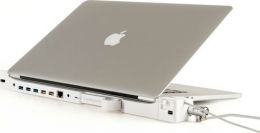
- Macbook pro docking station how to#
- Macbook pro docking station pro#
- Macbook pro docking station windows#
Most commonly, docking stations for MacBook Pros will include Thunderbolt 3 cables, though other models may include additional display ports like HDMI, Thunderbolt 1 and 2 Mini DisplayPort jacks and USB-C ports, among others still. If you plan to use one or more monitors with your MacBook, your docking station will need to include the display port types you plan to use with those monitors.
Macbook pro docking station windows#
Many docking stations designed for computers with Windows may not work for Apple’s line of products, so it’s especially important to check with a given product listing to ensure compatibility with your computer.
Macbook pro docking station pro#
Ultimately, it’s important to avoid buying a docking station that isn’t compatible with your MacBook Pro to save you the headache. What to look for in a quality MacBook Pro docking station Compatible Another common type of non-display port to look for in a MacBook Pro docking station is the USB-A 3.0 port, used for flash drives and other file-transferring uses, as well as for charging devices. While MacBook Pro docking stations will need to include a MacBook charger, they’ll also commonly include Thunderbolt 3 ports that can transfer files at 40 gb/s – not to be confused with slower, identically-shaped USB-C ports that only transfer at 10 gb/s while still working for many Thunderbolt 3 applications. The types of non-display ports you need may also determine what models are best for you if file transferring or charging are your primary needs. Some models may not include charging or file transfer ports at all, and may instead be designed only for use with external displays. Still, if you’re getting a docking station mainly for displays, you may only need to worry about what display ports are offered and vice versa. Those designed for MacBook Pro units will also often include Thunderbolt 3 ports for super high-speed file transferring, charging and optimal functionality. Docking stations usually offer multiple external display options, file transferring ports and charging abilities. What you need in a docking station will also determine which units will work best for you. Still, many of the best laptop docking stations can work with MacBooks in addition to Windows computers, though checking compatibility lists for your specific model is a great way to avoid having to return the item. The type of MacBook Pro you have may determine which docking stations you can use, especially if it’s older than Apple’s recent models that include a touch bar.


What to know before you buy a MacBook Pro docking station MacBook Pro type If you’re looking for a straightforward, stylish docking station, this Brydge Vertical MacBook Pro Docking Station is an excellent solution for dual monitor use, and it even includes a venting system to keep your computer cool. Still, you can also transfer files using many docking stations, and they often let you charge devices while you work. The best MacBook Pro docking stations offer a lot of versatility to the user, though, for many, the primary purpose of buying these products is to add external monitor displays.
Macbook pro docking station how to#
This guide to the top MacBook docking stations for your Apple laptop will help you find the desktop peripheral setup that's right for you. (For a higher-level overview of docking-station options, check out our guide to how to pick a laptop docking station.Which Macbook Pro docking station is best? If you don't want to rely on a whole host of USB-C adapters or dongles back at your desk, a docking station can be your best solution short of buying a desktop Mac. At certain times, you want to work on a single laptop screen in the living room, and at others, you buckle down at a desk with a more elaborate multi-screen setup and desktop peripherals.

And in these fraught days, with most business travel reduced to wearing a path in the carpet between your home office and the kitchen, flexibility matters. But many offices around the globe still rely on legacy ports such as HDMI and USB 3.0, not to mention SD card readers and Ethernet for wired connections. Thunderbolt and wireless connectivity are perfectly serviceable for most mobile professionals while they're out and about. Check out our primers on Thunderbolt 3 and Thunderbolt 4 to learn what makes Thunderbolt different from USB-C. Like Henry Ford's Model T, which gave you a choice of colors (so long as you chose black), modern MacBooks give you your choice of ports, so long as they are Thunderbolt ports.Īpple uses Thunderbolt 3 on laptops with Intel processors, and Thunderbolt 4 on laptops with Apple's own M1 processor.


 0 kommentar(er)
0 kommentar(er)
